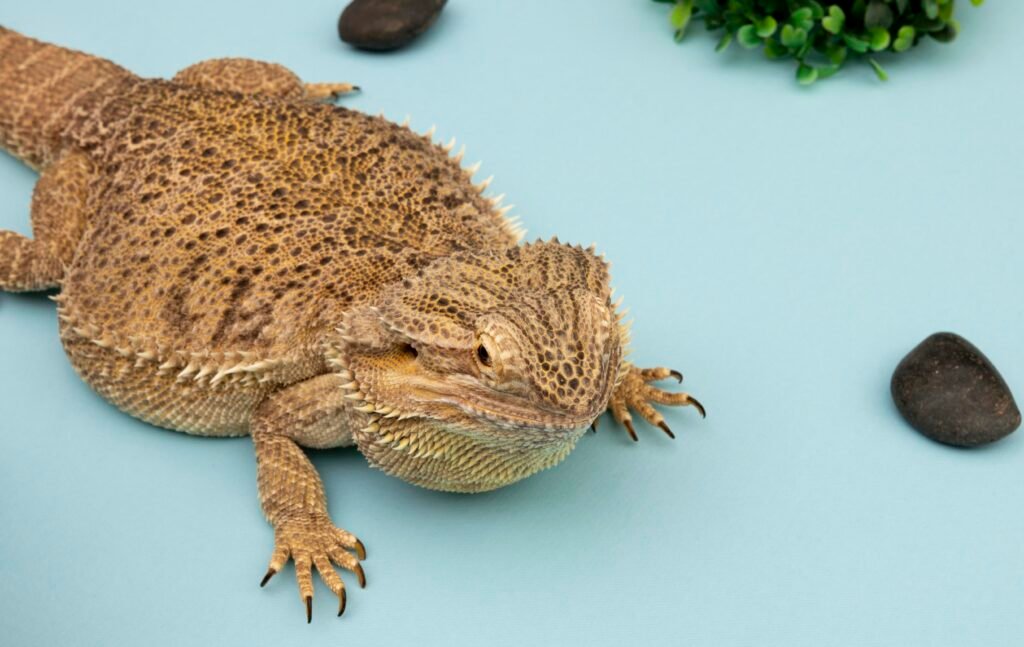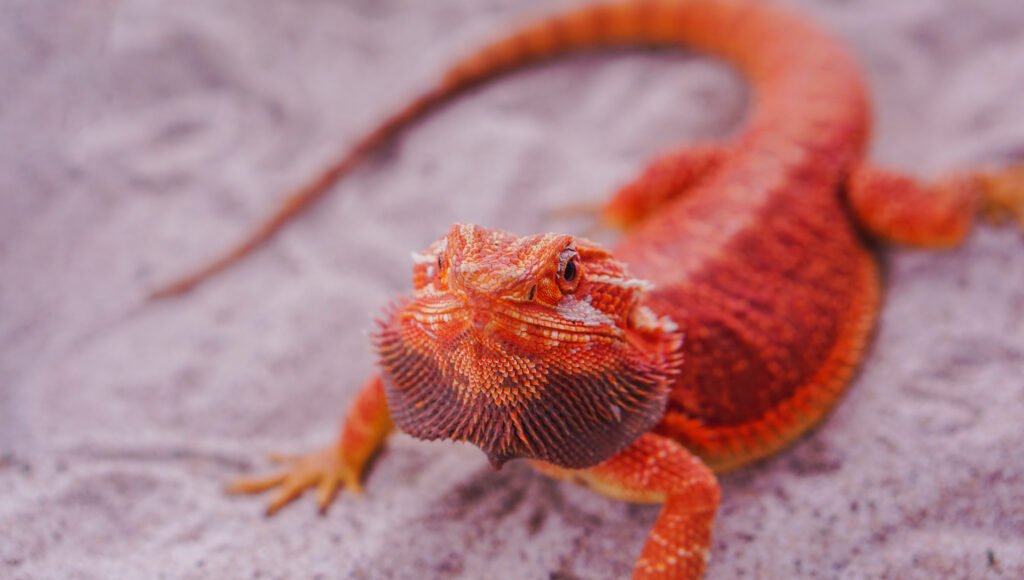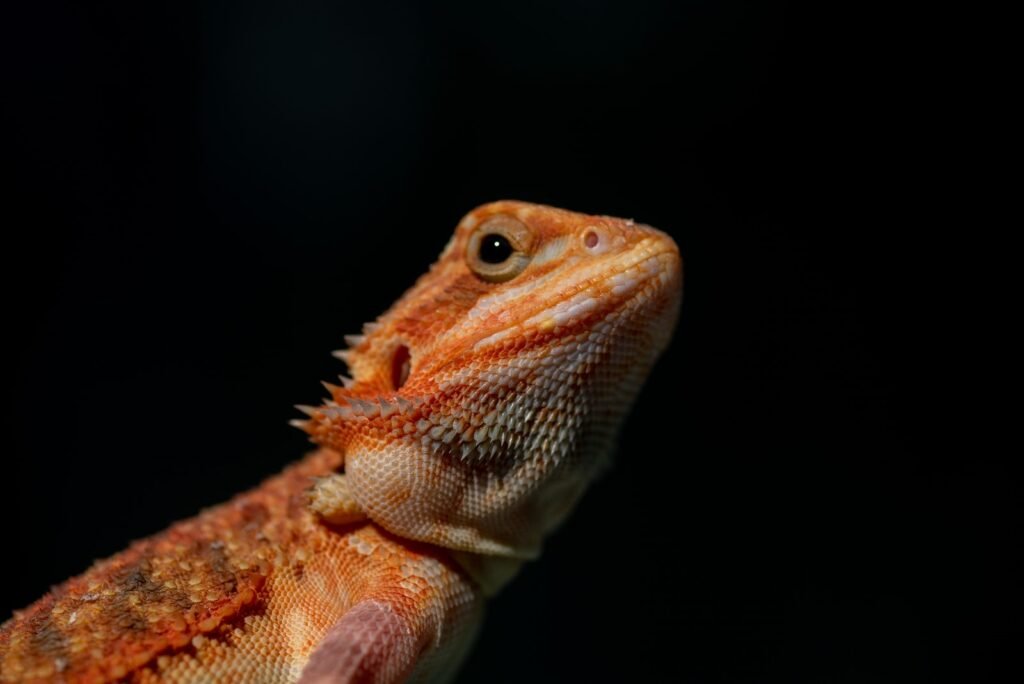If you’ve ever owned a bearded dragon, you might have noticed them acting a bit sluggish, hiding more often, and even refusing their favorite snacks during the colder months. Don’t panic! This is likely not a sign of illness, but a natural process called brumation.

- 🧐Bearded Dragon Brumation – What's the Big Deal?
- ☝Is Your Bearded Dragon in Brumation? Spotting the Sleepy Signs
- 📋How To Prepare Your Bearded Dragon for Brumation
- 🦎What Happens During Bearded Dragon Brumation?
- ➡️How To Guide Your Bearded Dragon Out of Brumation
- ⛔Oops, I Almost Ruined Brumation! Avoid These Common Mistakes
- ❓FAQ
🧐Bearded Dragon Brumation – What’s the Big Deal?
Think of brumation as a lizard version of hibernation. It’s a period of slowed-down activity where your beardie conserves energy and takes a long snooze. This behavior is instinctual for bearded dragons in the wild, a way to survive through harsh conditions with limited food and warmth.
In captivity, not every bearded dragon goes through brumation, and it’s not necessarily essential for their health. But if your scaly friend decides to take a winter “vacation,” understanding what’s going on is crucial to ensuring their well-being throughout the process.
So, why should you even care about brumation? Well, knowing the signs, preparing your beardie’s environment, and understanding what to expect when they wake up ensures they’ll come out of it happy and healthy. No more worrying if your dragon is just sleeping or if something’s wrong!
This guide will break down everything you need to know about bearded dragon brumation. From recognizing the early signs to ensuring they have a comfortable place to sleep it off, and finally, getting them back to their usual energetic selves, we’ve got you covered.
Let’s explore the fascinating world of brumation so you can learn how to support your bearded dragon during this natural process!
☝Is Your Bearded Dragon in Brumation? Spotting the Sleepy Signs
How do you know if your normally energetic beardie is simply embracing their inner couch potato for the winter or if something else is going on? Let’s look at the telltale signs of brumation and how to tell them apart from potential health problems.
🔎Brumation Clues
👉Sleep Champ – If your bearded dragon is suddenly sleeping more than usual, especially during the day, it could be a brumation signal. They might burrow under their substrate or retreat to a dark corner of their tank.
👉Food Strike – Don’t worry if their appetite takes a nosedive. Brumating bearded dragons naturally lose interest in food since their metabolism slows down.
👉Chilled Out – Their body temperature might drop a bit, and they’ll likely prefer the cooler side of their enclosure.
👉MIA Poop – Don’t be alarmed if their bathroom breaks become less frequent. Eating less means pooping less!
🚩Red Flags – When to Worry
While the above behaviors are normal during brumation, here’s what could indicate a health issue:
📌Significant Weight Loss – If your beardie is rapidly shedding pounds, it could be a sign of illness, not just brumation weight loss.
📌Runny Poop or Vomiting – These are not typical brumation signs and warrant a trip to the vet.
📌Labored Breathing or Discharge – Any respiratory issues should be addressed immediately.
📌Sores or Injuries – If you notice any skin problems or injuries, they could be signs of infection.
💚Age and Health Matter – Not Every Beardie Brumates
It’s worth noting that not all bearded dragons will brumate in captivity. Several factors come into play:
🔹Age – Younger dragons (under a year old) are less likely to brumate.
🔹Health – Bearded dragons with health problems shouldn’t brumate, as it can worsen their condition.
🔹Environment – If their tank temperatures remain warm and consistent, they might not feel the urge to brumate.
🩺The Vet’s Verdict
If you’re unsure whether your bearded dragon is brumating or ill, it’s always best to consult a reptile veterinarian. They can give your beardie a check-up and determine if any underlying health issues need attention. Remember, being proactive is key to keeping your scaly friend happy and healthy!
So you learned to spot the signs of brumation and concluded your beardie is entering this stage. The next step is to prep your dragon for a comfortable snooze.
📋How To Prepare Your Bearded Dragon for Brumation
Once you’ve determined that your bearded dragon is entering brumation, it’s time to create a cozy and safe environment for their long winter nap. Think of it as setting up a relaxing retreat for them to recharge!
Mandatory Health Check
Before your beardie starts snoozing, it’s crucial to get the green light from your reptile veterinarian.
They’ll check for any underlying health issues that could worsen during brumation. Think of it as a pre-vacation check-up, ensuring your dragon is in tip-top shape before heading off to their slumber party!
Creating a Brumation Oasis
✔️Separate Sleeping Quarters – Brumating dragons need a quieter, less stimulating environment than their usual habitat. Set up a separate “brumation box” or tank in a cool, dark, and quiet area of your home.
✔️Temperature is Key – Keep the temperature in the brumation box within the recommended range of 50-65°F (10-18°C). Use a reptile thermometer to ensure consistent temperatures throughout.
✔️Burrowing Bliss – Provide a layer of substrate, such as reptile carpet, paper towels, or a mixture of soil and sand, to allow your dragon to burrow and feel secure. Avoid loose substrates that could be accidentally ingested.
✔️Keep it Simple – Do not use extra decorations like rocks, branches, or basking lamps. Keep the setup minimalist to promote restfulness.
✔️Hydration is Still Important – Even in brumation, your beardie needs to stay hydrated. Offer a shallow dish of fresh, clean water, but don’t be concerned if they don’t drink much.
Easing into Brumation
✔️Gradual Transition – Avoid abrupt changes in temperature and lighting! Over a few weeks, gradually decrease the basking temperature, shorten the duration of light exposure, and offer less food. This mimics the natural seasonal changes that trigger brumation.
✔️Bath Time – Before starting brumation, give your bearded dragon a lukewarm bath to help them hydrate and clear their digestive system.
Remember, patience is key! Brumation is a natural process, and each dragon has its own timeline. By providing a safe and comfortable environment, you can help your beardie have a restful and healthy brumation. In the next part, we’ll discuss what to expect while they’re snoozing and how to care for them during this time.
🦎What Happens During Bearded Dragon Brumation?
Now that your bearded dragon is settled into their comfy brumation quarters, you might be wondering what they’re up to in there. It might seem like they’re just sleeping, but there’s actually a lot more going on beneath the surface!
🔹Slowed Metabolism – During brumation, your beardie’s metabolism drastically slows down. Think of it like hitting the “pause” button on their usual energy expenditure. This allows them to conserve energy during the colder months when food is scarce in the wild.
🔹Reduced Activity – Brumating bearded dragons will barely move and might not even come out of their hide for weeks or months. This is completely normal, so don’t panic!
🔹Infrequent Elimination – Due to the slower metabolism and minimal food intake, your dragon will rarely poop or pee during brumation. However, if you do see waste, it’s crucial to clean it up promptly to maintain hygiene.
🔹Weight Loss – It’s common for bearded dragons to lose a little weight during brumation. Don’t worry, this is natural. Just make sure they haven’t lost a significant amount, as that could be a red flag for potential issues.
Keeping an Eye on Your Sleeping Beauty
🔹Regular Check-Ins – Aim to check on your dragon every few days to ensure their health and safety. Look for signs of dehydration (sunken eyes, wrinkled skin), injuries, or any unusual behavior.
🔹Hands-Off Approach – While monitoring is important, avoid unnecessary handling. This can disrupt their sleep and add stress.
🔹Hydration Station – Even though they’ll be less active, a shallow water dish should always be available in case they need a sip.
When to Sound the Alarm
While most bearded dragons will brumate without a hitch, it’s important to be aware of these potential warning signs:
🔸Drastic Weight Loss – Losing more than 10% of their body weight is a red flag.
🔸Signs of Illness – Look for wheezing, nasal discharge, or swollen limbs, as these could indicate a respiratory infection or other issues.
🔸Prolonged Inactivity – If your beardie hasn’t moved in several weeks, it might be time for a vet visit.
The bottom line? Brumation is a natural process for many bearded dragons, and with proper care, it can be a healthy and restful experience. By monitoring their well-being and knowing the warning signs, you can ensure your scaly friend wakes up refreshed and ready for springtime adventures. Stay tuned for the next part, where we’ll discuss the exciting process of waking them up and getting them back into their usual routine.
➡️How To Guide Your Bearded Dragon Out of Brumation
As the days get longer and warmer, you’ll start to notice a shift in your beardie’s behavior. It’s time for their long winter’s nap to come to an end! But hold on – just like we need a slow wake-up call, so does your dragon. Here’s how to help them transition out of brumation safely:
Reverse the Process, Slow and Steady
👉Gradual Temperature Increase – Over a period of 7-10 days, slowly raise the temperature of your bearded dragon’s brumation enclosure. Start by bumping it up by a few degrees each day until it reaches their normal basking temperature (around 100-110°F/37.7-43.3°C).
👉Let There Be Light – Gradually reintroduce light to their environment. Start with a few hours of light per day and slowly increase it to their regular 12-14 hour cycle.
👉Tempting Tummy Treats – Offer small amounts of their favorite insects and fresh greens. Don’t be discouraged if they’re not interested right away. Their appetite will gradually return. You can find out more about nutrition essentials in our bearded dragon diet guide.
👉Bath Time Bliss – Once they show more interest in food, offer a lukewarm bath to help rehydrate them and stimulate their digestive system.
👉Post-Brumation Vet Check – After your bearded dragon is fully awake and active, schedule a check-up with your reptile vet. They’ll assess their overall health and ensure they’ve made a healthy transition out of brumation.
👉Back to Normal – As your dragon readjusts to their regular routine, watch for any lingering signs of lethargy, difficulty eating, or dehydration. Offer plenty of water and a balanced diet to help them regain their strength.
Remember, brumation is a natural part of many bearded dragons’ lives. While it might seem strange at first, it’s simply their way of adapting to seasonal changes. By following these guidelines, you can ensure that your beardie wakes up from their winter slumber happy, healthy, and ready to enjoy the sunshine with you once again!
⛔Oops, I Almost Ruined Brumation! Avoid These Common Mistakes
Brumation might seem simple enough – your bearded dragon gets sleepy, you lower the lights, and voila! But as with most things reptile-related, there’s more to it than meets the eye. Don’t fall into these common pitfalls that can disrupt or even endanger your beardie’s winter rest.
Mistake #1 – The Goldilocks Zone (It’s Not Just for Porridge)
📌Too Cold is Risky – While beardies need cooler temps, don’t let it get too chilly. Temperatures below 50°F (10°C) can be dangerous, slowing down their body functions too much and even leading to illness.
📌Too Warm is Just Plain Wrong – If the environment’s too warm, your dragon won’t get the signals it needs to properly brumate. They might wake up frequently, stressing them out and depleting their energy reserves.
📌Get it Right – Aim for a sweet spot of 50-65°F (10-18°C) and monitor it consistently with a thermometer.
Mistake #2 – The “Let Sleeping Dragons Lie” Rule
📌No Forced Waking – If your beardie is snoozing soundly, resist the urge to wake them up for cuddles or a quick snack. This abrupt disruption can be very stressful.
📌Exceptions Exist – If you notice alarming signs like significant weight loss, injuries, or respiratory problems, it’s time to consult a vet who can safely evaluate your dragon.
Mistake #3 – Skipping the Pre-Brumation Checkup
Before you dim the lights, schedule a check-up with your reptile vet. They’ll ensure your bearded dragon is healthy enough for brumation and doesn’t have any underlying conditions that could worsen during this period.
Mistake #4 – The Food Dilemma
📌No Last Suppers – Don’t overfeed your dragon right before brumation. They need an empty digestive system to avoid potential issues while sleeping.
📌But Don’t Completely Starve Them – Gradually reduce their food intake in the weeks leading up to brumation, rather than abruptly cutting them off.
Mistake #5 – The Dreaded Substrate Swap
If your beardie is used to a certain type of substrate, stick with it in their brumation enclosure. Changing it can add unnecessary stress to the process. Visit our bearded dragon habitat setup guide to read about the best types of substrate for beardies.
By avoiding these common blunders, you’ll help your bearded dragon have a smooth and successful brumation experience. Remember, it’s all about providing a safe and comfortable environment for their well-deserved winter rest.



